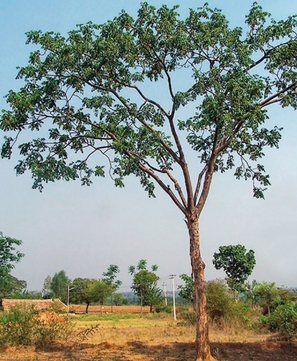Quelques propriétés physiques du bois de Melia dubia délignifié et comprimé
DOI :
https://doi.org/10.19182/bft2019.341.a31758Mots-clés
bois comprimé, délignification, recouvrance de la compression, perte d’épaisseur, Inde.Résumé
Cette étude explore les effets de la délignification dans l’amélioration de quelques propriétés physiques du bois comprimé. Les billes de bois d’une plantation de six ans d’âge de Melia dubia (densité = 0,39 g/cm3) ont été délignifiées dans une solution alcaline de NaOH et Na2SO3 pendant 4 heures. Les billes de bois délignifiées ont été séchées jusqu’à contenir 12 % d’humidité, et comprimées à deux températures (120 °C et 150 °C) pendant 2 heures et 4 heures. Les améliorations dans la densité, la recouvrance de la compression (%) et la perte d’épaisseur (%) après la compression ont été observées et comparées avec des échantillons non délignifiés. La densité moyenne du bois délignifié et comprimé (DCW) était de 0,825 g/cm3 (SD = 0,109) ; pour le bois comprimé sans délignification (CW), la densité moyenne était de 0,889 g/cm3 (SD = 0,049). Ces densités diffèrent significativement : les échantillons de DCW ont montré une basse recouvrance de la compression (2,97 % à 5,22 %), tandis que, comparativement, les échantillons de bois CW ont montré une haute recouvrance de la compression (48,47 % à 38,05 %). La perte moyenne d’épaisseur (%) dans les échantillons de DCW a varié de 47,22 % à 52,26 %, et elle était approximativement de 10 % plus haute (58,77 % à 61,91 %) dans les échantillons de CW, sans délignification.
Téléchargements
Références
Abe H., Funada R., Kuroda N., Furusawa O., 2001. Confocal laser scanning microscopy of water uptake during the recovery of compressed and drying-set wood. IAWA Journal, 22 (1): 63-72. https://doi.org/10.1163/22941932-90000264
Dwianto W., Morooka T., Norimoto M., Kitajima T., 1999. Stress relaxation of sugi (Cryptomeria japonica D. Don) wood in radial compression under high temperature steam. Holzforschung, 53 (5): 541-546. https://doi.org/10.1515/HF.1999.089
Esteves B., Ribeiro F., Cruz-Lopes L., Domingos J. F. I., 2017. Densification and heat treatment of maritime pine wood. Wood Research, 62 (3): 373-388. http://ce3c.ciencias.ulisboa.pt/research/publications/ver.php?id=833
Higashihara T., Morooka T., Hirosawa S., Norimoto M., 2004. Relationship between changes in chemical components and permanent fixation of compressed wood by steaming or heating. Mokuzai Gakkaishi, 50: 159-167. https://jglobal.jst.go.jp/en/detail?JGLOBAL_ID=200902214551284397&rel=0
Hwang S., Lee W., 2011. Hardness and Dimensional Stability of Radiata Pine (Pinus radiata D. Don) Heat-Compressed Wood - Effect of Press Temperature & Time. Journal of the Korean Wood Science and Technology, 39 (3): 206-212. http://www.jwst.or.kr/past/list_sub.asp?srcCate=&i_key=6021&p_key=3020&v_key=39&n_key=3&n_key1=3&i_kname=&p_name=
Inoue M., Ogata S., Kawai S., Rowell R. M., Norimoto M., 1993a. Fixation of Compressed Wood Using Melamine-Formaldehyde Resin. Wood and Fiber Science, 25 (4): 404-410. https://wfs.swst.org/index.php/wfs/article/view/623/623
Inoue M., Norimoto M., Tanahashi M., Rowell R. M., 1993b. Steam or heat fixation of compressed wood. Wood and Fiber Science, 25 (3): 224-235. https://wfs.swst.org/index.php/wfs/article/view/288
Ito Y., Tanahashi M., Shigematsu M., Shinoda Y., 1998. Compressive-molding of wood by high-pressure steam-treatment. Part 2: Mechanism of permanent fixation. Holzforschung - International Journal of the Biology, Chemistry, Physics and Technology of Wood, 52 (2): 217-221. https://doi.org/10.1515/hfsg.1998.52.2.217
JieYing W., GuangJie Z., Iida I., 2000. Effect of oxidation on heat fixation of compressed wood of China fir. Forestry Studies in China, 2 (1): 73-79.
Kumar S., Bhushan U. K., Mishra A. K., Jena S. K., 2018. Variability in physical properties of plantation-grown progenies of Melia composita and determination of a kiln drying schedule. Journal of Forestry Research, 29: 1435-1442. https://doi.org/10.1007/s11676-017-0527-z
Morsing N., Hoffmeyer P., 1998. Densification of Wood. The influence of hygrothermal treatment on compression of beech perpendicular to gain. Kongens Lyngby, Denmark, Technical University of Denmark (DTU). http://orbit.dtu.dk/en/publications/densification-of-wood(5e00be8d-891d-4a4d-b5e8-102e7bbaeadd).html
Navi P., Girardet F., 2000. Effects of thermo-hydro-mechanical treatment on the structure and properties of wood. Holzforschung - International Journal of the Biology, Chemistry, Physics and Technology of Wood, 54 (3): 287-293. https://doi.org/10.1515/HF.2000.048
Sandermann W., Augustin H., 1964. Chemical investigations on the thermal decomposition of wood. Part III: Chemical investigation on the course of decomposition. Holz als Roh- und Werkstoff, 22: 377-386. https://doi.org/10.1007/BF02628346
Senol S., Budakci M., 2016. Mechanical wood modification method. Mugla Journal of Science and Technology, 2 (2): 53-59. http://dergipark.ulakbim.gov.tr/muglajsci/article/view/5000205925
Song J., Chen C., Zhu S., Zhu M., Dai J., Ray U., 2018. Processing bulk natural wood into a high-performance structural material. Nature, 554 (8): 224-228. https://doi.org/10.1038/nature25476

Téléchargements
Numéro
Rubrique
-
Résumé505
-
PDF459
Reçu
Accepté
Publié
Comment citer
Licence
(c) Tous droits réservés CIRAD - Bois et Forêts des Tropiques 2022

Ce travail est disponible sous la licence Creative Commons Attribution 4.0 International .
 Les articles sont publiés en Accès libre. Ils sont régis par le Droit d'auteur et par les licenses créative commons. La license utilisée est Attribution (CC BY 4.0).
Les articles sont publiés en Accès libre. Ils sont régis par le Droit d'auteur et par les licenses créative commons. La license utilisée est Attribution (CC BY 4.0).








